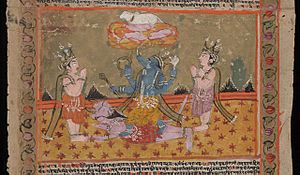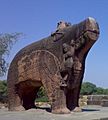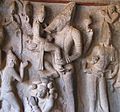Varaha facts for kids
Hindus believe that Vishnu has many important forms, called Avatars. The Varaha avatar was the third of these forms. In this avatar, Vishnu appeared as a black varaha. The word "Varaha" comes from the Sanskrit language and means a boar.
Hindu stories tell us about this special avatar. There was a powerful daitya (a demon) named Hiranyaksha. This demon threw the Earth (which Hindus call Prithivi) into the deep waters of the ocean. The Earth was about to sink completely.
At that moment, Vishnu took the form of a black boar. He went into the water and carefully lifted the Earth on his body. He then brought the Earth safely back to its proper place. So, Vishnu, as the Varaha boar, saved the world from being destroyed.
Contents
What is an Avatar?
In Hinduism, an avatar is when a god, like Vishnu, comes down to Earth in a different form. This form could be an animal, a human, or even a mix of both. Gods take these forms to help people, defeat evil, or restore balance in the world.
The Story of Varaha and Hiranyaksha
The Demon's Challenge
Hiranyaksha was a very strong and evil demon. He loved causing trouble and showing off his power. One day, he decided to challenge the gods and even the Earth itself. He used his great strength to pull the Earth from its place and drag it down into the cosmic ocean.
Vishnu's Plan to Save the Earth
The Earth was in great danger of being lost forever in the deep waters. The gods and other beings were worried. They prayed to Vishnu for help. Vishnu heard their prayers and knew he had to act quickly to save the world.
The Boar's Rescue Mission
Vishnu decided to take on the form of a mighty boar. This boar was strong and powerful, perfect for diving into the deep ocean. He plunged into the water, searching for the Earth. When he found it, he carefully lifted it with his tusks. He carried the Earth out of the water and placed it back in its rightful spot in the universe. This act saved all living things.
Images for kids
-
3rd century sandstone Varaha sculpture, Art of Mathura, housed in LACMA.
-
Varaha with his consort Bhudevi, copper sculpture from Tamil Nadu. c. 1600.
-
Scene from the Thai version of the Ramayana - the Ramakien - Vishnu (Witsanu) transforms into a boar to kill the demon Hiranyaksha (Hiranta) who curls the earth up in an attempt to take over the world.
-
Zoomorphic Varaha, Khajuraho. On its body are carved saints, sages, gods, seven mothers and numerous beings which he symbolically protects. The goddess earth is ruined and missing.
-
Coin with Varaha on a Gurjara-Pratihara coin possibly from the reign of King Mihira Bhoja, 850–900 CE, British Museum.
-
Varaha as the left head in the Vaikuntha Chaturmurti icon of Vishnu. Mathura, Gupta period, mid-5th century CE. Boston Museum.
-
A rare right-facing Varaha holding Bhudevi, 7th century CE, Mahabalipuram.
See also
 In Spanish: Varaja para niños
In Spanish: Varaja para niños












